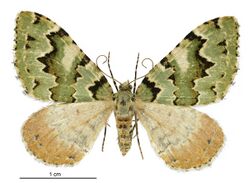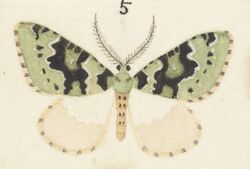Biology:Asaphodes adonis
| Asaphodes adonis | |
|---|---|

| |
| Male | |

| |
| Female | |
| Scientific classification | |
| Domain: | Eukaryota |
| Kingdom: | Animalia |
| Phylum: | Arthropoda |
| Class: | Insecta |
| Order: | Lepidoptera |
| Family: | Geometridae |
| Genus: | Asaphodes |
| Species: | A. adonis
|
| Binomial name | |
| Asaphodes adonis (Hudson, 1898)[1]
| |
| Synonyms[1] | |
| |
Asaphodes adonis (also known as the exquisite carpet moth) is a species of moth in the family Geometridae.[2] It is endemic to the South Island of New Zealand. It is found in native forest at altitudes of between 300 and 1200 metres. Larvae have been reared on species of Ranunculus. Adults are on the wing in January and February.
Taxonomy
This species was first described by George Vernon Hudson in 1898 under the name Xanthorhoe adonis using specimens collected at Castle Hill or at the Routeburn.[3] Hudson went on to discuss and illustrate this species in his book The butterflies and moths of New Zealand.[4] In 1939 Louis Beethoven Prout placed this species in the genus Larentia.[5] This placement was not accepted by New Zealand taxonomists.[6] In 1971 J. S. Dugdale placed this species in the genus Asaphodes.[7] In 1988 Dugdale affirmed this placement in his catalogue of New Zealand Lepidoptera.[2] The type specimens have not been located at Te Papa.[2] Dugdale presumed that the syntype series of specimens Hudson sent to Meyrick is held in the Natural History Museum, London.[2]
Description
Hudson originally described this species as follows:
The expansion of the wings is 1 inch. The fore-wings are vivid green : there is a broad, wavy, black transverse line near the base ; a somewhat broken line at about one-third, much broader on the costa and edged with white towards the base; a very conspicuous lima// black line at two-thirds, shaded towards the base, and sharply edged with white towards flic termen ; between this line and the termen there are several black marks, forming another extremely broken transverse line. The hind-wings arc pale orange-brown, with a faint grey central band.[3]
A. adonis has vivid green forewings with dark coloured broad wavy lines edged with white which form a distinctive pattern.[3] The dark coloured wavy lines can vary considerably in thickness.[4] The hind wings are a pale orange shaded brown.[3] This species can be distinguished from its close relative Asaphodes beata by the colour of its hind wings.[8]
Distribution and habitat
This species is endemic to New Zealand and is found in the South Island only.[1][9] It is regarded as uncommon and is found in native forest in the South Island at altitudes of between 300 and 1200 metres.[3][10] A. adonis have been observed at Castle Hill and Lake Wakatipu,[3] Lake Harris track,[11] Bold Peak in Otago,[10] Mt Aspiring Station,[12] and in the Te Anau Ecological District.[13]
Behaviour
Adults of this species are on the wing in January and February.[3][10] It can be found during the day resting on tree trunks, camouflaged against similar coloured lichen growth.[14]
Host plant
Larvae of A. adonis have been reared on species of Ranunculus.[15]
References
| Wikimedia Commons has media related to Asaphodes adonis. |
- ↑ 1.0 1.1 1.2 "NZOR Name Details - Asaphodes adonis (Hudson, 1898)". Landcare Research New Zealand Ltd. http://www.nzor.org.nz/names/e8b094ec-cf40-4353-913b-ed21c2b00b01.
- ↑ 2.0 2.1 2.2 2.3 , pp. 172, Wikidata Q45083134
- ↑ 3.0 3.1 3.2 3.3 3.4 3.5 3.6 , pp. 63, Wikidata Q19073637
- ↑ 4.0 4.1 , pp. 117, Wikidata Q58593286
- ↑ Prout, L. B. (1939). "Geometridae: Fauna Indo-Australica". The Macrolepidoptera of the World 12: 264. https://www.biodiversitylibrary.org/page/12779936.
- ↑ , Wikidata Q54670161
- ↑ , Wikidata Q64006453
- ↑ Meyrick, E (1908). "Notes and descriptions of New Zealand lepidoptera." (in en). Transactions and Proceedings of the New Zealand Institute 41: 6. https://www.biodiversitylibrary.org/page/3312287#page/24/mode/1up.
- ↑ , p. 458, Wikidata Q45922947
- ↑ 10.0 10.1 10.2 Hamilton, H. (1911). "Notes on entomological collecting tours during the seasons 1908-1909 and 1909-1910." (in en). Transactions and Proceedings of the New Zealand Institute 43: 123. https://www.biodiversitylibrary.org/page/9782162#page/133/mode/1up.
- ↑ Hudson, G. V. (1906). "On entomology of the Routeburn Valley." (in en). Transactions and Proceedings of the New Zealand Institute 39: 202. https://www.biodiversitylibrary.org/page/9975287#page/228/mode/1up.
- ↑ Mt Aspiring Station Conservation Resources Report Part 1 (Report). Department of Conservation. November 2005. p. 34. http://www.linz.govt.nz/crown-property/crown-pastoral-land/status-and-location-crown-pastoral-land/mt-aspiring-station. Retrieved 11 February 2017.
- ↑ Mcrea, Amber (12 April 2016). "Asaphodes adonis Observed by amber_mcrae February 2, 2016". http://naturewatch.org.nz/observations/2920487.
- ↑ Crowe, Andrew (2017) (in English). Which New Zealand insect?. Penguin Books. pp. 20. ISBN 978-0-14-100636-9. https://www.wikidata.org/wiki/Q105622564.
- ↑ Patrick, Brian (April 2000). "Conservation status of two rare New Zealand Geometrid moths". Science for Conservation 45: 1–21. ISSN 1173-2946. http://www.doc.govt.nz/Documents/science-and-technical/sfc145.pdf. Retrieved 10 February 2017.
Wikidata ☰ Q28739815 entry
 |



